Thursday, April 1, 1943
In the North Atlantic... The Italian blockade-runner Pietro Orseolo is attacked off the coast of Spain by British Beaufort and Beaufighter torpedo bombers. Escorting German destroyers shoot down 5 of the aircraft. After dark, the US submarine Shad hits the ship with a torpedo, causing substantial damage.
Friday, April 2, 1943
In the Aleutian Islands... American aircraft conduct 8 raids on Kiska and one on Attut.
Saturday, April 3, 1943
In Tunisia... Attacks by American General Patton's 2nd Corps around El Guettar are held by the Axis defenders.
Sunday, April 4, 1943
Over Germany... British Bomber Command aircraft drop 1300 tons of bombs on Kiel during a night raid.
Over Britain... German aircraft drop mines in the Thames Estuary.
Monday, April 5, 1943
In Burma... The Japanese on the Mayu peninsula continue their advance northwestward, in the direction of Indin.
In Tunisia... The Axis defenses on the Wadi Akarit Line have been improved over the course of the past few days. The line is occupied, mostly, by Italian troops. The German 15th Panzer and 90th Light Divisions are held in reserve behind the line. Most of the Axis armor is further north, engaging the US 2nd Corps around El Guettar. In the evening the British 4th Indian Division begins a night advance against the Djebel Fatnassa position. Good progress is achieved.
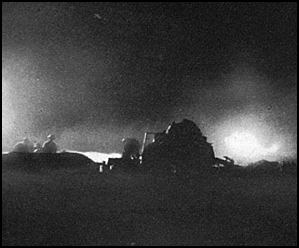
Tuesday, April 6, 1943
In Tunisia... In the morning, following the silent advance of the British 4th Indian Division during the night, a follow-up attack is launched. It proves poorly coordinated and draws in the Axis reserve (the German 15th Panzer and 90th Light Divisions) during the day.
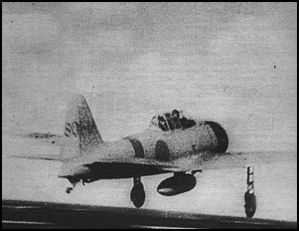
Wednesday, April 7, 1943
In the Solomon Islands... In an effort to disrupt the American buildup, Japanese Admiral Yamamoto mounts an air offensive known as Operation I. The Japanese 11th Air Fleet, based on Rabaul, Kavieng and Buin is reinforced by pilots and aircraft of the carriers Zuikaku, Shokaku, Junyo and Hiyo. This leaves the Imperial Navy with almost no trained pilots. The attacks begin with a raid against Guadalcanal and Tulagi by 180 planes in which a destroyer and two other vessels are sunk.
In Tunisia... Axis forces are rapidly retreating from the Wadi Akarit Line. Patrols of the British 8th Army and the US 2nd Corps meet on the road toward Gafsa.
In Germany... Hitler and Mussolini meet at Salzburg over the course of the next five days (April 7-11). Among other topics discussed, they decide they must continue to hold on in North Africa.
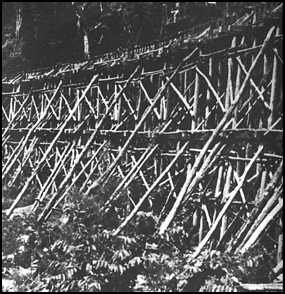
Thursday, April 8, 1943
In Burma... General Kawabe replaces General Iida in command of Japanese forces, which are now organized as the Burma Area Army. The Japanese are planning to extend their hold on northern Burma. Among the logistical preparations are the construction of new rail lines. About 60,000 Allied prisoners of war are employed in this work and about 15,000 will die through ill treatment.From Washington
... In an effort to control inflation, President Roosevelt forbids certain wage and price increases. He also orders workers not to change jobs in some industries unless this is beneficial to the war effort.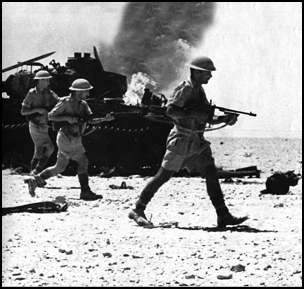
Friday, April 9, 1943
In Tunisia... The British 8th Army captures Mahares, 50 miles north of Gabes as the Axis forces continue to retreat.
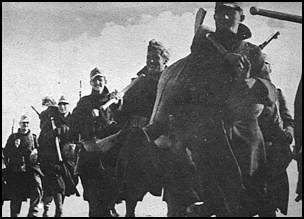
Saturday, April 10, 1943
In Tunisia... Forward elements of the British 8th Army enter Sfax. The British 9th Corps succeeds in breaking out from the Fondouk Pass -- to late to cut off the enemy. The Axis retreat continues.
Over Sardinia... A force of 84 Liberator bombers raids La Maddalena sinking the heavy cruiser Trieste and damaging the Gorizia.
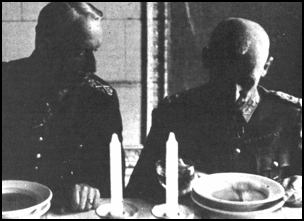
Sunday, April 11, 1943
On the Eastern Front... The Germans are planning for an attack on the Kursk salient. The German generals are divided over the plan. Kluge (Commanding Army Group Center), Zeitzler (Chief of the General Staff, OKH) and Keitel (Commander in Chief, OKW) are in favor. Guderian (Inspector General of Panzer Troops) and Manstein (Commander, Army Group South) are opposed. Manstein, in fact, originally suggested such an attack.
In New Guinea... Two Allied freighters are sunk in Oro Bay by Japanese air attacks.

Monday, April 12, 1943
In Occupied Poland... The Germans announce the discovery of a group of mass graves in the Katyn Forest. The bodies of 4100 Polish officers killed by the Soviets during their occupation of the region, are found.
In Tunisia... The retreating Axis forces reach Enfidaville.
In New Guinea... Port Moresby is attacked by 174 Japanese aircraft in their ongoing offensive. Little significant damage is done.
Tuesday, April 13, 1943
In the Aleutian Islands... US bombers conduct day and night raids on Kiska Island.
In the North Atlantic... The British destroyer HMS Eskdale is sunk off the Lizard Head, Cornwall (in southwestern England) by German motor torpedo boats during the night (April 13-14).

Wednesday, April 14, 1943
In Tunisia... Axis forces are now established in what will be their final defensive positions. They occupy the ring of hills around Bizerta and Tunis from about Cape Serrat to Enfidaville. British 8th Army units are moving up from the south to pressure Djebel Garci and Takrouna.
In New Guinea... A Japanese raid on Allied shipping in Milne Bay sinks two transports. This is the last of the series of attacks carried out in their air offensive. Japanese losses have been heavy.
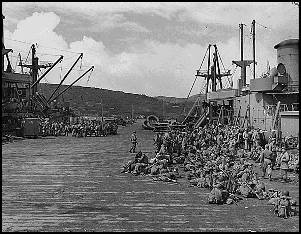
Thursday, April 15, 1943
In the Aleutian Islands... US forces prepare for an invasion of Attu Island, held by the Japanese. The US 7th Division, preparing for deployment in North Africa, is earmarked for the operation.
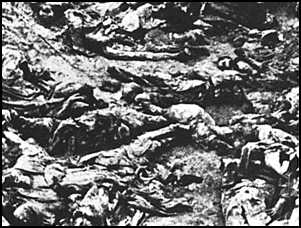
Friday, April 16, 1943
In London... The Polish government in exile issues a statement on the Katyn massacre asking for a Red Cross investigation.
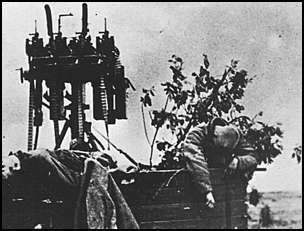
Saturday, April 17, 1943
On the Eastern Front... In the Caucasus, Soviet forces continue to press the German 17th Army holding on in the Kuban Peninsula.
Over Germany... The US 8th Air Force carries out a daylight bombing raid on aircraft factories in Bremen. Of 115 B-17 bombers employed, 16 are lost on the mission.
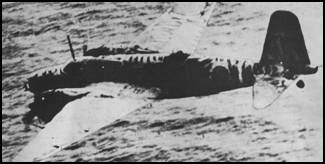
Sunday, April 18, 1943
Over the Solomon Islands... An aircraft carrying the Commander of the Japanese Combined Fleet, Admiral Yamamoto, is shot down by P-38 Lighting fighters over Bougainville. Yamamoto is killed. This action is the result the interception of a coded Japanese message announcing a visit by Yamamoto. The Japanese fail to deduce that their codes are insecure.
In Moscow... The Soviets state that the story of the Katyn massacre is nothing more than German propaganda.
In Tunisia... A massive convoy of 100 transport aircraft leaves Sicily with supplies for the Axis forces. At least half the planes are shot down by Allied fighters.
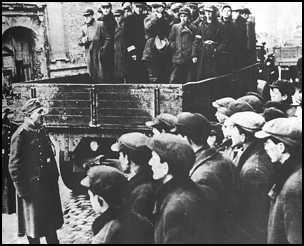
Monday, April 19, 1943
In Occupied Poland... The remaining population of the Warsaw ghetto rises against the Germans.
In Tunisia... Another effort to supply the Axis forces by air suffers heavy losses.
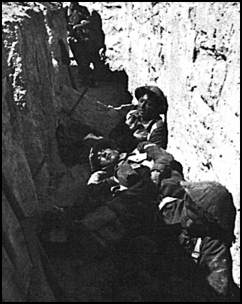
Tuesday, April 20, 1943
In Tunisia... The British 8th Army (Montgomery) launches a series of unsuccessful attacks on Axis positions near Enfidaville. The Allied forces suffer heavy casualties.
In Tokyo... The Japanese Cabinet is reorganized with Shimegitsu becoming Foreign Minister.

Wednesday, April 21, 1943
From Tokyo... Admiral Koga is appointed to succeed Yamamoto as Commander in Chief of the Japanese Combined Fleet.
In Tunisia... An Axis attack around Medjex el Bab is defeated.

Thursday, April 22, 1943
In Tunisia... A series of Allied attacks are launched against the Axis positions in the hills. The US 2nd Corps (now commanded by General Bradley) attacks Hill 609 in "Mousetrap Valley," with the objective of advancing to Mateur. The British 5th Corps attacks "Longstop" and "Peter's Corner" and the British 9th Corps attacks between Boubellat and Bou Arada. Montgomery has been ordered to cease his attacks along the coast. Meanwhile, another Axis air supply effort results in 30 transports being shot down.
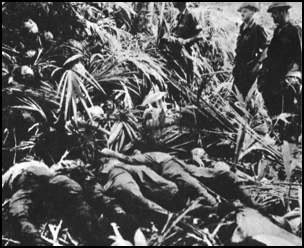
Friday, April 23, 1943
In New Guinea... Australian troops occupy positions around Mubo unopposed.
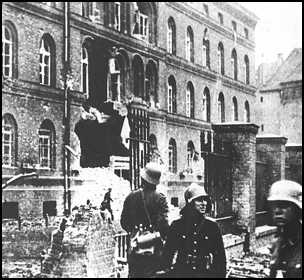
Saturday, April 24, 1943
In Occupied Poland... The SS begins operations against the Jews in the Warsaw ghetto. Buildings are burned or blown up but resistance continues. Jewish fighters make use of the sewers and the rubble to continue their struggle. Those Jews captured are either shot immediately or transported to the death camps.
Sunday, April 25, 1943
Over Italy... American bombers raid an airfield around Bari in the south.
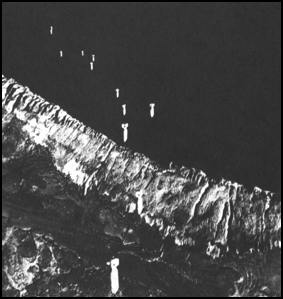
Monday, April 26, 1943
In the Aleutian Islands... An American squadron under the command of Admiral McMorris bombards the Japanese held harbors on Attu Island.
From Moscow... The Soviet government breaks off diplomatic relations with the London based Polish government in exile because of the allegations concerning the Katyn massacre.
In Tunisia... "Longstop" hill is captured by the British 5th Corps. The Churchill tanks used in the attack have proven useful in the hilly terrain.
From Washington... New plans are approved for the Solomon Islands operatoins (code named "Cartwheel"). Admiral Halsey's South Pacific Area forces are to advance through New Georgia and Bougainville. MacArthur's Southwest Pacific Area is to continue its advance northwest along the coast of New Guinea until he and Halsey can link up to isolate the Japanese bases at Rabaul and Kavieng.
Tuesday, April 27, 1943
In Tunisia... British forces occupy Djebel Bou Aoukaz after an intensive battle.
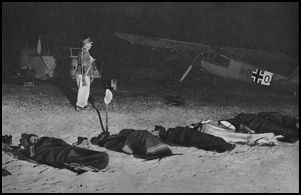
Wednesday, April 28, 1943
In Tunisia... The German 8th Panzer Regiment counterattacks the British forces that have occupied Djebel Bou Aoukaz. American forces make some gains in "Mousetrap Valley."
In the Atlantic... Convoy ONS-5 is attacked by 51 U-boats over the course of a following week (April 28-May6th). It loses 13 ships (out of 42) but 7 U-boats are sunk, 5 are seriously damaged and 12 are slightly damaged. This is considered a successful rate of exchange for the Allied convoys.
Thursday, April 29, 1943
In North Africa... British forces capture Sidi Abdallah.
In Berlin... Hitler meets with the prime minister of Vichy France, Pierre Laval.
In Occupied Poland... A German sponsored 11 member "International Medical Commission" dissects 8 Polish corpses, found at Katyn, and reports that Soviet forces committed the massacre in the spring of 1940, using German small arms.
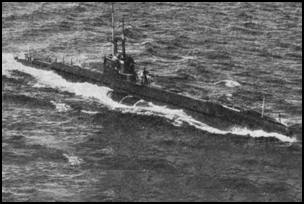
Friday, April 30, 1943
In Spain... As part of a deception plan for the invasion of Sicily (Operation Husky), the British submarine Seraph releases a corpse into the sea off the Spanish port of Huelva hoping it will be picked up and the papers carried passed on to the Germans. The body purports to be that of a Major Martin of the Royal Marines and he is carrying letters from General Nye, Vice-Chief of the British General Staff, and Admiral Mountbatten, Chief of Combined Operations, to Eisenhower, Alexander and Cunningham referring to Allied plans for an invasion of Greece. The Germans do receive the information and it contributes to their lack of appreciation of the true Allied strategy.
In Tunisia... The Germans retake Djebel Bou Aoukaz. Farther north, the American gain a foothold on Hill 609. Alexander decides to switch veteran units from the British 8th Army to join a renewed attack between Bou Aoukaz and Ksar Tyr.
From London... The Polish government in exile drops its call for a Red Cross enquiry into the Katyn massacre in an attempt to reestablish relations with the USSR.
Copyright © 2018 Ralph Zuljan
